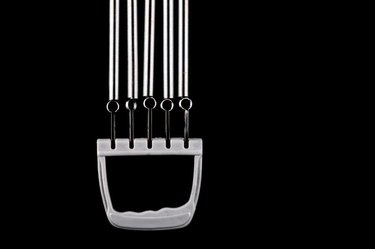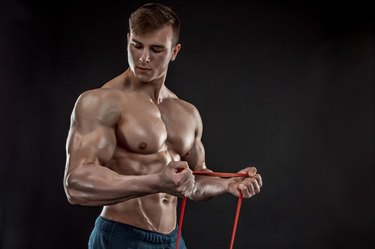
It doesn't get much more old school than the spring chest expander. Way back in the late 1800s, Eugen Sandow — the first bodybuilding showman to emphasize showing off his physique rather than his lifting strength — popularized this simple, iconic resistance workout.
Better known as "strand pulling," working out with resistance bands — which commonly come as rubber tubes rather than metal springs nowadays — offers a variety of band-only exercises, as well numerous ways to intensify existing techniques as an accessory. Naturally, the muscles worked depend on the exercise in question.
Video of the Day
Video of the Day
Solo Springs
With the traditional metal spring version of this accessory, you'll mostly be working the pecs — hence, the name, "chest expander." Various exercises mimic the motions of weight-based chest workouts, like the pushing motion of chest presses, or the arcing, arms-outstretched movement characteristic of dumbbell flyes.
Both of these pulls target the sternal heads of the pectoralis major — the middle chest muscles that often just go by "pecs" — but they also engage the upper pectoral muscles, or the clavicular heads of the pectoralis major. As a secondary focus, you'll work the deltoids, triceps and biceps with either type of movement.
Accessory Activation

Flexible and durable resistance bands made of rubber can do the job of traditional spring-based chest expanders, but they can also be added to existing exercises to add additional resistance. For example, pulling strands as an addition to squats helps intensify the exercise, offering a challenging thigh workout.
In a workout known as "burner push-ups," stretching two resistance bands across the upper back can boost the recruitment of muscles like the pecs, delts, triceps and biceps.
If your spring or bands can be securely mounted or tied to a stable surface, you can perform pulley-like workouts. With this technique, exercises like pulldowns work the back (particular the lats) while back presses hit the deltoids and triceps.
More on Strands
We've just scratched the surface of muscles that can be activated via strand pulling — you can span the workout spectrum from lying leg curls for your quads to body twists for your core — but the way they work your muscles is worth noting, too.
Expanders, bands and cables aren't subject to gravity; they simply get harder to pull the further you stretch. This makes them a potentially powerful tool for real-world and martial arts strength training, as it closely mimics the act of grappling a living opponent (speaking of gravity, you won't have to worry about weights falling on your head).
This pulling motion also helps your body develop stability and balance, as you lead resistance movements against gravity. And, while you're fighting that gravity, you'll grab another bonus, too: An aerobic response that adds a cardio-layer to your workout.
Read more: Resistance Band Chest Exercises
Do You Pull?
Strand pulling might not be as popular as it was in Eugen Sandow's day, but resistance bands still have a fervent fanbase — are you among them? If so, what are some of your favorite strand-pulling and resistance band exercises for different muscle groups? Don't resist; head down to the comments below and let us know.